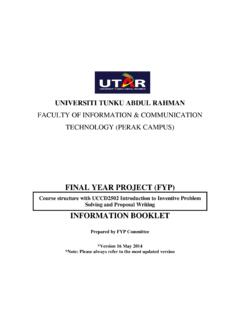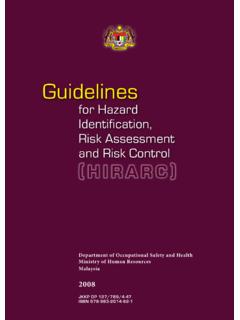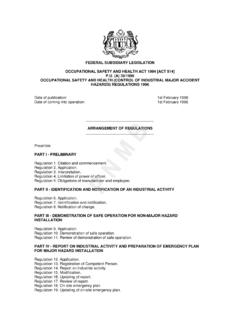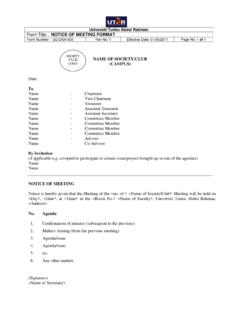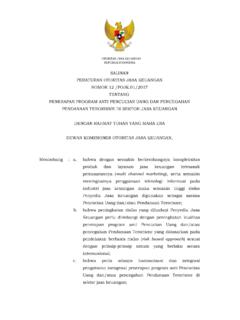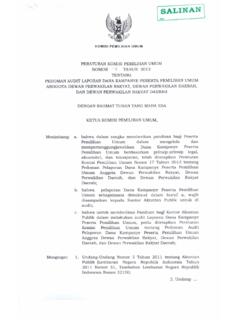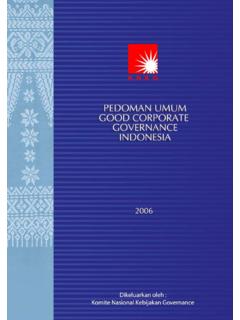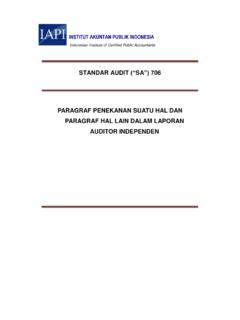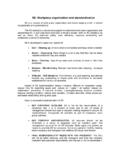Transcription of Revised Bloom’s Taxonomy - Universiti Tunku …
1 Revised bloom s Taxonomy Revised bloom s Taxonomy (RBT) employs the use of 25 verbs that create collegial understanding of student behavior and learning outcome. Retrieved from: bloom s Revised Taxonomy Taxonomy of Cognitive Objectives 1950s- developed by Benjamin bloom Means of expressing qualitatively different kinds of thinking Been adapted for classroom use as a planning tool Continues to be one of the most universally applied models Provides a way to organise thinking skills into six levels, from the most basic to the more complex levels of thinking 1990s- Lorin Anderson (former student of bloom ) revisited the Taxonomy As a result, a number of changes were made(Pohl, 2000, Learning to Think, Thinking to Learn, pp.)
2 7-8) Original Terms New Terms Evaluation Synthesis Analysis Application Comprehension Knowledge Creating Evaluating Analysing Applying Understanding Remembering(Based on Pohl, 2000, Learning to Think, Thinking to Learn, p. 8) Retrieved from: Change in Terms The names of six major categories were changed from nounto verbforms. As the Taxonomy reflects different forms of thinking and thinking is an active process verbs were used rather than nouns. The subcategories of the six major categories were also replaced by verbs and some subcategories were reorganised. The knowledge category was renamed.
3 Knowledge is an outcome or product of thinking not a form of thinking per se. Consequently, the word knowledge was inappropriate to describe a category of thinking and was replaced with the word remembering instead. Comprehension and synthesis were retitled to understanding and creating respectively, in order to better reflect the nature of the thinking defined in each bloom S Revised TAXONOMYC reatingCreatingGenerating new ideas, products, or ways of viewing thingsDesigning, constructing, planning, producing, a decision or course of actionChecking, hypothesising, critiquing, experimenting, judgingAnalysingAnalysingBreaking information into parts to explore understandings and relationshipsComparing, organizing, deconstructing, interrogating.
4 FindingApplyingApplyingUsing information in another familiar situationImplementing, carrying out, using, executingUnderstandingUnderstandingExpla ining ideas or conceptsInterpreting, summarising, paraphrasing, classifying, explainingRememberingRememberingRecallin g informationRecognizing, listing, describing, retrieving, naming, finding Retrieved from: The Cognitive Dimension Process Level 1 - C1 Categories & Cognitive Processes Alternative Names Definition Remember Retrieve knowledge from long-term memory Recognizing Identifying Locating knowledge in long-term memory that is consistent with presented material Recalling Retrieving Retrieving relevant knowledge from long-term memory Level 2 C2 Categories & Cognitive Processes Alternative Names Definition Understand Construct meaning from instructional messages, including oral, written.
5 And graphic communication Interpreting Clarifying Paraphrasing Representing Translating Changing from one form of representation to another Exemplifying Illustrating Instantiating Finding a specific example or illustration of a concept or principle Classifying Categorizing Subsuming Determining that something belongs to a category Summarizing Abstracting Generalizing Abstracting a general theme or major point(s) Inferring Concluding Extrapolating Interpolating Predicting Drawing a logical conclusion from presented information Comparing Contrasting Mapping Matching Detecting correspondences between two ideas, objects, and the like Explaining Constructing models Constructing a cause and effect model of a system Anderson, Lorin W.
6 & Krathwohl, David R. (2001). A Taxonomy for Learning, Teaching and Assessing: a Revision of bloom s Taxonomy . New York. Longman Publishing. Level 3 C3 Categories & Cognitive Processes Alternative Names Definition Apply Applying a procedure to a familiar task Executing Carrying out Applying a procedure to a familiar task Implementing Using Applying a procedure to an unfamiliar task Analyze Break material into its constituent parts and determine how the parts relate to one another and to an overall structure or purpose Differentiating Discriminating Distinguishing Focusing Selecting Distinguishing relevant from irrelevant parts or important from unimportant parts of presented material Organizing
7 Finding coherence Integrating Outlining Parsing Structuring Determining how elements fit or function within a structure Attributing Deconstructing Determine a point of view, bias, values, or intent underlying presented material Evaluate Make judgments based on criteria and standards Checking Coordinating Detecting Monitoring Testing Detecting inconsistencies or fallacies within a process or product; determining whether a process or product has internal consistency; detecting the effectiveness of a procedure as it is being implemented Critiquing Judging Detecting inconsistencies between a product and external criteria; determining whether a product has external consistency; detecting the appropriateness of a procedure for a given problem Anderson, Lorin W.
8 & Krathwohl, David R. (2001). A Taxonomy for Learning, Teaching and Assessing: a Revision of bloom s Taxonomy . New York. Longman Publishing. Categories & Cognitive Processes Alternative Names Definition Create Put elements together to form a coherent or functional whole; reorganize elements into a new pattern or structure Generating Hypothesizing Coming up with alternative hypotheses based on criteria Planning Designing Devising a procedure for accomplishing some task Producing Constructing Inventing a product The Knowledge Dimension Dimension Definition Factual Knowledge The basic elements students must know to be acquainted with a discipline or solve problems in it Conceptual Knowledge The interrelationships among the basic elements within a
9 Larger structure that enable them to function together Procedural Knowledge How to do something, methods of inquiry, and criteria for using skills, algorithms, techniques, and methods Metacognitive Knowledge Knowledge of cognition in general as well as awareness and knowledge of one s own cognition Anderson, Lorin W. & Krathwohl, David R. (2001). A Taxonomy for Learning, Teaching and Assessing: a Revision of bloom s Taxonomy . New York. Longman Publishing. Potential Activities and Products Remembering: Potential Activities and Products Make a list of the main events of the story. Make a time line of events.
10 Make a facts chart. Write a list of any pieces of information you can remember. What animals were in the story? Make a chart Make an acrostic. Recite a poem. Understanding: Potential Activities and Products Cut out, or draw pictures to show a particular event. Illustrate what you think the main idea may have been. Make a cartoon strip showing the sequence of events. Write and perform a play based on the story. Retell the story in your own words. Write a summary report of the event Prepare a flow chart to illustrate the sequence of events. Make a coloring book. Cut out, or draw pictures to show a particular event.
